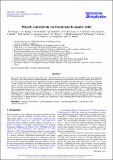Por favor, use este identificador para citar o enlazar a este item:
http://hdl.handle.net/10261/260412COMPARTIR / EXPORTAR:
 SHARE SHARE
 CORE
BASE CORE
BASE
|
|
| Visualizar otros formatos: MARC | Dublin Core | RDF | ORE | MODS | METS | DIDL | DATACITE | |

| Campo DC | Valor | Lengua/Idioma |
|---|---|---|
| dc.contributor.author | Tristram, M. | es_ES |
| dc.contributor.author | Banday, A. J. | es_ES |
| dc.contributor.author | Górski, K. M. | es_ES |
| dc.contributor.author | Keskitalo, R. | es_ES |
| dc.contributor.author | Lawrence, C. R. | es_ES |
| dc.contributor.author | Andersen, K. J. | es_ES |
| dc.contributor.author | Barreiro, R. Belén | es_ES |
| dc.contributor.author | Borrill, J. | es_ES |
| dc.contributor.author | Eriksen, H. K. | es_ES |
| dc.contributor.author | Fernández-Cobos, R. | es_ES |
| dc.contributor.author | Kisner, T. S. | es_ES |
| dc.contributor.author | Martínez-González, Enrique | es_ES |
| dc.contributor.author | Partridge, Bruce | es_ES |
| dc.contributor.author | Scott, Douglas | es_ES |
| dc.contributor.author | Svalheim, T. L. | es_ES |
| dc.contributor.author | Thommesen, H. | es_ES |
| dc.contributor.author | Wehus, I. K. | es_ES |
| dc.date.accessioned | 2022-02-10T08:42:39Z | - |
| dc.date.available | 2022-02-10T08:42:39Z | - |
| dc.date.issued | 2021 | - |
| dc.identifier.citation | Astronomy and Astrophysics 647: A128 (2021) | es_ES |
| dc.identifier.uri | http://hdl.handle.net/10261/260412 | - |
| dc.description.abstract | We present constraints on the tensor-to-scalar ratio r using Planck data. We use the latest release of Planck maps, processed with the NPIPE code, which produces calibrated frequency maps in temperature and polarisation for all Planck channels from 30 GHz to 857 GHz using the same pipeline. We computed constraints on r using the BB angular power spectrum, and we also discuss constraints coming from the TT spectrum. Given Planck’s noise level, the TT spectrum gives constraints on r that are cosmic-variance limited (with σr = 0.093), but we show that the marginalised posterior peaks towards negative values of r at about the 1.2σ level. We derived Planck constraints using the BB power spectrum at both large angular scales (the ‘reionisation bump’) and intermediate angular scales (the ‘recombination bump’) from ℓ = 2 to 150 and find a stronger constraint than that from TT, with σr = 0.069. The Planck BB spectrum shows no systematic bias and is compatible with zero, given both the statistical noise and the systematic uncertainties. The likelihood analysis using B modes yields the constraint r < 0.158 at 95% confidence using more than 50% of the sky. This upper limit tightens to r < 0.069 when Planck EE, BB, and EB power spectra are combined consistently, and it tightens further to r < 0.056 when the Planck TT power spectrum is included in the combination. Finally, combining Planck with BICEP2/Keck 2015 data yields an upper limit of r < 0.044. | es_ES |
| dc.description.sponsorship | Planck is a project of the European Space Agency (ESA) with instruments provided by two scientific consortia funded by ESA member states and led by Principal Investigators from France and Italy, telescope reflectors provided through a collaboration between ESA and a scientific consortium led and funded by Denmark, and additional contributions from NASA (USA). Some of the results in this paper have been derived using the HEALPix package. This research used resources of the National Energy Research Scientific Computing Center (NERSC), a U.S. Department of Energy Office of Science User Facility operated under Contract No. DE-AC02-05CH11231. We gratefully acknowledge support from the CNRS/IN2P3 Computing Center for providing computing and data-processing resources needed for this work. | es_ES |
| dc.language.iso | eng | es_ES |
| dc.publisher | EDP Sciences | es_ES |
| dc.relation.isversionof | Publisher's version | es_ES |
| dc.rights | openAccess | es_ES |
| dc.subject | Cosmology: observations | es_ES |
| dc.subject | Cosmic background radiation | es_ES |
| dc.subject | Cosmological parameters | es_ES |
| dc.subject | Gravitational waves | es_ES |
| dc.title | Planck constraints on the tensor-to-scalar ratio | es_ES |
| dc.type | artículo | es_ES |
| dc.identifier.doi | 10.1051/0004-6361/202039585 | - |
| dc.description.peerreviewed | Peer reviewed | es_ES |
| dc.relation.publisherversion | https://doi.org/10.1051/0004-6361/202039585 | es_ES |
| dc.identifier.e-issn | 1432-0746 | - |
| dc.rights.license | https://creativecommons.org/licenses/by/4.0 | es_ES |
| dc.contributor.funder | European Space Agency | es_ES |
| dc.contributor.funder | National Aeronautics and Space Administration (US) | es_ES |
| dc.contributor.funder | National Energy Research Scientific Computing Center (US) | es_ES |
| dc.contributor.funder | Department of Energy (US) | es_ES |
| dc.contributor.funder | Centre National de la Recherche Scientifique (France) | es_ES |
| dc.relation.csic | Sí | es_ES |
| oprm.item.hasRevision | no ko 0 false | * |
| dc.identifier.funder | http://dx.doi.org/10.13039/501100004794 | es_ES |
| dc.identifier.funder | http://dx.doi.org/10.13039/100000015 | es_ES |
| dc.identifier.funder | http://dx.doi.org/10.13039/501100000844 | es_ES |
| dc.identifier.funder | http://dx.doi.org/10.13039/100000104 | es_ES |
| dc.type.coar | http://purl.org/coar/resource_type/c_6501 | es_ES |
| item.cerifentitytype | Publications | - |
| item.openairecristype | http://purl.org/coar/resource_type/c_18cf | - |
| item.grantfulltext | open | - |
| item.openairetype | artículo | - |
| item.fulltext | With Fulltext | - |
| item.languageiso639-1 | en | - |
| Aparece en las colecciones: | (IFCA) Artículos | |
Ficheros en este ítem:
| Fichero | Descripción | Tamaño | Formato | |
|---|---|---|---|---|
| planckratio.pdf | 1,52 MB | Adobe PDF |  Visualizar/Abrir |
CORE Recommender
SCOPUSTM
Citations
72
checked on 29-abr-2024
WEB OF SCIENCETM
Citations
70
checked on 29-feb-2024
Page view(s)
46
checked on 01-may-2024
Download(s)
45
checked on 01-may-2024
Google ScholarTM
Check
Altmetric
Altmetric
Este item está licenciado bajo una Licencia Creative Commons

